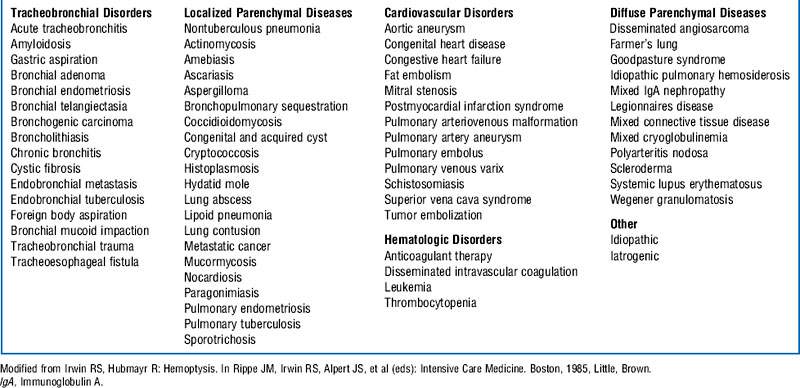Chapter 25 Hemoptysis
1 What is hemoptysis?
 Scant hemoptysis refers to expectoration of sputa that are tinged or streaked with blood.
Scant hemoptysis refers to expectoration of sputa that are tinged or streaked with blood.
 Frank hemoptysis is characterized by sputa that are grossly bloody but of a low volume (less than 100-200 mL in 24 hours).
Frank hemoptysis is characterized by sputa that are grossly bloody but of a low volume (less than 100-200 mL in 24 hours).
 Massive hemoptysis refers to bleeding that is potentially acutely life threatening. It is inconsistently defined but generally describes expectoration of at least 200 mL of blood within a 24-hour period. Most authors limit the definition of massive hemoptysis to expectoration of more than 600 mL of blood in 24 hours.
Massive hemoptysis refers to bleeding that is potentially acutely life threatening. It is inconsistently defined but generally describes expectoration of at least 200 mL of blood within a 24-hour period. Most authors limit the definition of massive hemoptysis to expectoration of more than 600 mL of blood in 24 hours.
3 Describe the differential diagnosis of hemoptysis
The differential diagnosis of hemoptysis is based on the site of bleeding. Hemoptysis in general results from either a focal or a diffuse tracheobronchial (airway) or pulmonary parenchymal process (Box 25-1). Occasionally nonpulmonary processes, in particular cardiac, vascular, or hematologic disorders, may result in bleeding in the lungs. The frequency with which hemoptysis is associated with these conditions is determined by the age of the patient, the population being studied (e.g., surgical vs. medical, veterans hospital vs. city or county indigent hospital), and the amount of expectorated blood. Approximately 30% of cases are cryptogenic, and no explanation for hemoptysis is determined despite extensive evaluation.
8 What is the initial approach to the evaluation of a patient with hemoptysis in the intensive care unit?
< div class='tao-gold-member'>
Stay updated, free articles. Join our Telegram channel

Full access? Get Clinical Tree



